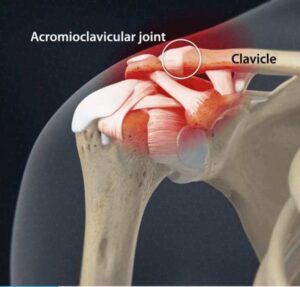The acromioclavicular joint (where the acromion, the tip of the shoulder blade (scapula) articulates with the collarbone) is a common area of pain in the sporting population. The AC joint consists of 3 ligaments; the inferior and superior acromioclavicular (AC) ligaments, and the coracoacromial (CC) ligament (which consists of the conoid and trapezoid ligaments). The joint essentially acts as a pivot point to aid in scapular and shoulder motion.
Whilst acute injuries to this area are typically associated with direct trauma (falls onto the shoulder, collisions in contact field sports), AC joint pain in combat sport athletes, particularly striking athletes, often presents as a gradual onset injury. The susceptibility to pain in this area is increased if an athlete has had an acute AC joint injury in the past. These athletes may often present with the step deformity between the two bones. The attached photo is of my shoulders, and you will notice a difference in the appearance between sides!
Common causes of AC joint injury are changes in technique and rapid changes in training load, and excessive volume of pressing exercises. Poor scapular control, as well as limitations in thoracic spine (upper back) and hip mobility may place excessive strain on the joint during punching. Changes in training equipment (using a heavier pad/changing from paddles to training mitts) may expose the shoulder to increased compressive load.
Holding mitts/pads also places compressive load on the AC joint, and this may be particularly relevant for coaches, or athletes also doing coaching, as well as those in a class environment where both parties are taking turns holding pads.
In part 2 we will discuss pain management.
#thescienceofstriking #boxing #kickboxing #shoulderpain #shoulderinjury #acjoint #rehabiliation #physiotherapy
